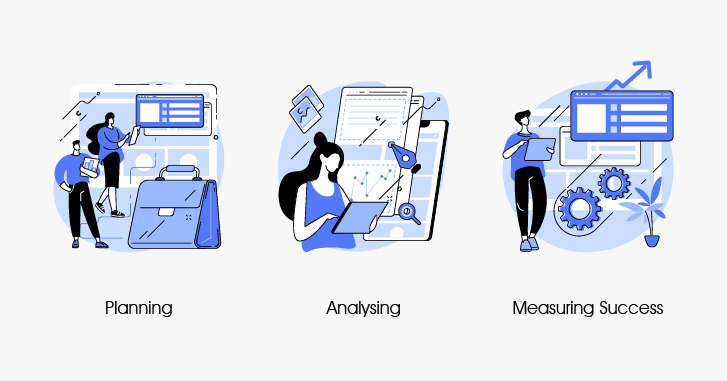
Although UI/UX design is a critical skill for web developers, it’s still clear that many lack an in-depth understanding of this field. UI/UX design is a set of skills that have become indispensable. In an era where web page design and experience affect the decisions that consumers make.
It’s important to establish that user interface and user experience are not interchangeable terms. They are, however, tied together. A good UI can lead to a good UX, but with a lousy UI, it’s near impossible for your users to enjoy a good UX on your website or app.
UX analysis is more valuable than ever given that the focus of every organization is ensuring an optimal user experience.
What is UX Analysis and why is it important?

UX design attempts to create the most fitting interaction between an application or web page with a user. Whereas UX analysis attempts to measure and understand the meaning behind its results.
UX analysis is the process of measuring the interactions of a user and a UI and attempting to make them valuable for future use. It involves setting out principles and guidelines that assist the use of a digital product and its user flow.
A/B testing and heat mapping are just a few of the many techniques that are used in UX analysis. That is to help understand user interactions with a website or application. For example, data on page stay time and bounce rates can be accessed easily. Moreover, it can enable an understanding of key changes that may need to be made to the UI.
So, why is UX analysis important for your business?
The first important use of UX analysis is to identify flaws in existing websites or Apps. Usability testing and evaluations identify components that are difficult for users to understand. By addressing them, the end-user experience becomes both satisfying and simple to use.
Secondly, UX analysis helps with SEO. Which is being aware of the keywords that your users use, the pages that they spend the most time on, and the issues that should be dealt with first. This gives your business an edge in understanding which keywords should be emphasized on your website or application.
Furthermore, UX analysis assists businesses in positioning themselves well relative to their competitors. That means knowing what’s ‘working’ for other business owners, and what may not be working for you. This paves the way for designs to evolve. Allowing companies to manage the dynamic changes that occur in the business sphere.
Visitors on the page can be ‘made’ to increase their session duration, their page stay, and access more pages per session. This helps businesses achieve their ultimate goals: online lead generation and lead conversion.
Like all business analytics processes, however, UX analysis is not a one-size-fits-all solution.
Are There Different Types of UX Analysis?
This appears to be an interesting dilemma.
Various types of UX strategy can be used depending on an organization’s UX strategy.
Competitor Analysis:
The most popularly used UX research method is competitor analysis. This involves two major steps. The first one is understanding the information that needs to be thoroughly researched. And the second step is ensuring that the information is properly synthesized.
It is critical to have a deep understanding of the product in question. It is to ensure that competitive analysis with UX is as accurate as it is effective. In addition, you should understand how it compares to your competition. For this kind of research Heuristics and heuristic evaluation are used as guiding principles.
This enables users to identify market gaps that can be filled while also positioning the product effectively. The first step in conducting an effective competitor analysis is to know the organization’s objectives. In addition to conducting extensive research on the organization’s direct and indirect competitors. Through this, commonalities between competitors can be identified and capitalized. It thus ensures that the product reaches as many people as possible.
Although competitor analysis is useful, its scope and applicability are quite limited. Effective analysis is also allowed for several other types of UX research methods.
Accessibility Review:
Accessibility reviews are crucial because a UX design needs to be aimed at the broadest audience possible. Even so, they often are overlooked, accessibility reviews aim to make sure that UX designs are usable by audiences. Which may possess visual or auditory impairment individuals. For example, users that are colorblind will have difficulty navigating through web pages. Involving the one with color combinations that are difficult for them to interpret.
This type of analysis involves several aspects of a layout. Including font size and type, font color, and alt-text. If any of these are inaccessible to disabled users, the product becomes difficult to use and businesses lose access to a diverse audience.
Google Lighthouse is a useful tool for detecting visual barriers on web pages. It is an extension that rates, on a scale of 100, different parts of the UX design on a webpage. While also offering feedback to improve different design elements. Color contrast tests help UX designers by providing a table of color-blind-friendly shades. That is utilized to improve the general user experience.
Technical Review:
A UX technical review includes a look at the website’s performance, best practices, and SEO. Once an optimal design for the page has been proven, the above said parameters must be enhanced. This is for a better user experience, and it indicates the completion of a technical review.
A UX technical review will be able to assess the page speed of an app or a web page in terms of performance. It will also make recommendations to ensure its optimization. Page Speed Insights, powered by Google, is one of the best tools to see how your website performs in both of these areas. It offers guidance for increasing page speed. Examples include image optimization and asset caching.
‘Best practices’ refer to the adherence to industry and market-specific standards and guidelines. For example, incorporating print-media writing styles into digital media writing would be detrimental to web pages. That is because it would reduce their responsiveness. As stated before, Google Lighthouse is widely regarded as a useful tool for bringing said standards. However, it is still necessary to manually identify and resolve such issues.
The impact on SEO of including technical reviews in the UX analysis process is one of the best outcomes. Although it is not a standard process in UX analysis, SEO is critical in determining a website’s search appearance and rank. Moz is a useful tool for better understanding SEO. While receiving consistent feedback on improvement, and effectively implementing said changes.
Though the types of UX analysis may vary, the goals of UX analysis are homogenous. Which is making the user experience better for the future.
The Three Steps Towards Writing UX Analysis

Understanding how UX analyses operate and their significance poses the question: how do UX analyses operate?
The answer is more straightforward than you might have thought.
UX design analyses are often triggered by negative reviews of the webpage or application. It is either directly on the site, or on a third-party supporter (such as the App Store). However, the most astute organizations will conduct UX analyses regularly. So that user’s experience can be daily optimized.
Planning:
It is useful to plan the UX analysis thoroughly beforehand. Conducting a traffic flow analysis via Google Analytics is a useful place to start. As it has the capacity to highlight the different user segments that are present within a user flow. Which gives essential information on the end-user experience being provided by the page.
Secondly, identify the segments within the flow, and then choose a success metric for them. These can be identified in terms of conversion rates. Whether the goal is to improve user retention or to increase ad click-through, it is critical to record the desired outcomes with the provided data.
Thirdly, before the user flow process is recorded to analyze its performance, it is important to prioritize primary use cases. The user segments provide the most value with regard to performance, whether it is retention or revenue.
Finally, record the process in the user flow by clearing the cache and opening the website page by page. Each page can be ‘screenshotted’ and placed on a Sketch Artboard. This is to capture the subtlety in each step while laying them out to get a holistic picture of the entire service. It must be separately done for how the UX process appears to a new and returning user.
Analyzing:
Here, most of the actual ‘analyzing’ happens within the UX design analysis.
It is crucial to recognize user perceptions and expectations. To see whether each screen that has been laid out is communicating what it should be to the target audience. UX engineers and designers often miss out on this by refusing to ask themselves one question. Which is “If I was an’ average’ user, would I stay on this website or leave immediately?”
After positioning yourself in the shoes of the ‘average’ user, it is important to gauge usability heuristics through a heuristic evaluation. These are rules of thumb that rely on conventions that improve a product’s general usability. It emphasizes UX design principles and makes sure that they are adhered to.
The company should thoroughly examine the number of steps in each user flow. It is crucial to determine the number of interactions required to achieve the goals set for their respective segment. This helps determine the overall task’s complexity. And also whether certain processes or UX design changes can be made to simplify the user experience on the web page or app.
In the case of applications, it is critical to keep the application structure in mind in terms of relevant user segments and goals at this point. For certain segments of the application, users may lose previously saved data. Which could frustrate them and hence push them to exit the application entirely. In cases like this, the application would need to be restructured to save user data unless explicitly told not to. This is a common flaw in some banking applications. Even minimizing the application for a brief moment leads to the loss of all relevant transaction data and increases user anguish.
Measuring Success:
After changes have been implemented, it is important to conduct another UX analysis to see if the changes are favorable.
When doing this, consider the previous success metrics that were laid out in the ‘planning’ phase and see if they can be improved upon. Common metrics look like “increasing the conversion rate by streamlining the registering process and reducing the number of steps needed”.
Success can also be gauged by seeing if the finished product required more elements to be removed rather than added. Simpler UX designs are often easier to understand and are generally received better.
Finally, it is critical to ensure that data tracking is adjusted in order to detect future changes. Also, previous changes should be compared to see if there has been a net positive or negative change in the goals that needed to be met.
Though conducting a UX design analysis may appear time-consuming at first, it is a simple process. It only requires a keen eye for noticing minor details and a commitment to continuous improvement.
What Do UX Research and Reviews Achieve?
Whether for UX testing or implementation, UX analysis has become a need for organizations that aim to build a strong online presence.
The ideal UX design will always put the user before anyone else and understand the world from their shoes. Therefore, UX analysis incorporates as many perspectives as possible. From the competitor analysis point of view, it aims to position the product as unique in the market. Accessibility reviews attempt to create an inclusive UX design. While technical reviews incorporate performance indicators for the best possible end-user experience.
UX analysis is a detailed, thorough process. It requires intricate planning, which paints a picture of the process in its current state and objectives for improvement. It also necessitates actual analysis. which includes all the questions that must be asked. This is done to ensure that the defined goals are understood. It also assists in assessing performance and determining what adjustments are needed.
UX analytics is ultimately more than just a game of numbers, graphs, and charts.
In a world of abundant data, UX design is positively enabling massive strides in development. The field of UX analytics, therefore, needs to follow suit. Though its basic values remain constant, UX analysts must keep up with a rapidly evolving technology landscape.


